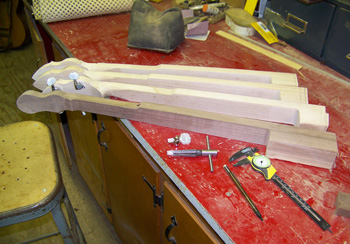Contouring the Neck
 The wood for the necks needs to be band sawn out and let to acclimate to the grain stresses for three months before work can start on the neck. (You have to work “with the wood’ not against it.). Once the top is belt sanded flat, the truss rod slot is laid out and routered. The fingerboard, heel cap, and peghead overlay is glued on and clamped overnight. Once inlaid bound, and fretted, we’re ready to drill the tuner holes and 5th string hole. The peghead is cut to whichever pattern was selected and sanded smooth. The shaping of the neck is next and slowly worked down to match the templates measured at specific frets. The thickness is monitored and worked closer and closer to the bindings, heel and peghead. The heel cut to the pot (assembly consisting or the rim, flange, head, tension hoop and hooks) is crucial for fit and sound. I use a jig mounted on a rotary table on a Bridgeport mill. By doing so, I can set the radius and neck angle very accurately and repeatable. Several test fits and it’s ready for the final sanding.
The wood for the necks needs to be band sawn out and let to acclimate to the grain stresses for three months before work can start on the neck. (You have to work “with the wood’ not against it.). Once the top is belt sanded flat, the truss rod slot is laid out and routered. The fingerboard, heel cap, and peghead overlay is glued on and clamped overnight. Once inlaid bound, and fretted, we’re ready to drill the tuner holes and 5th string hole. The peghead is cut to whichever pattern was selected and sanded smooth. The shaping of the neck is next and slowly worked down to match the templates measured at specific frets. The thickness is monitored and worked closer and closer to the bindings, heel and peghead. The heel cut to the pot (assembly consisting or the rim, flange, head, tension hoop and hooks) is crucial for fit and sound. I use a jig mounted on a rotary table on a Bridgeport mill. By doing so, I can set the radius and neck angle very accurately and repeatable. Several test fits and it’s ready for the final sanding.
The next step...Creating the Tone Ring.

